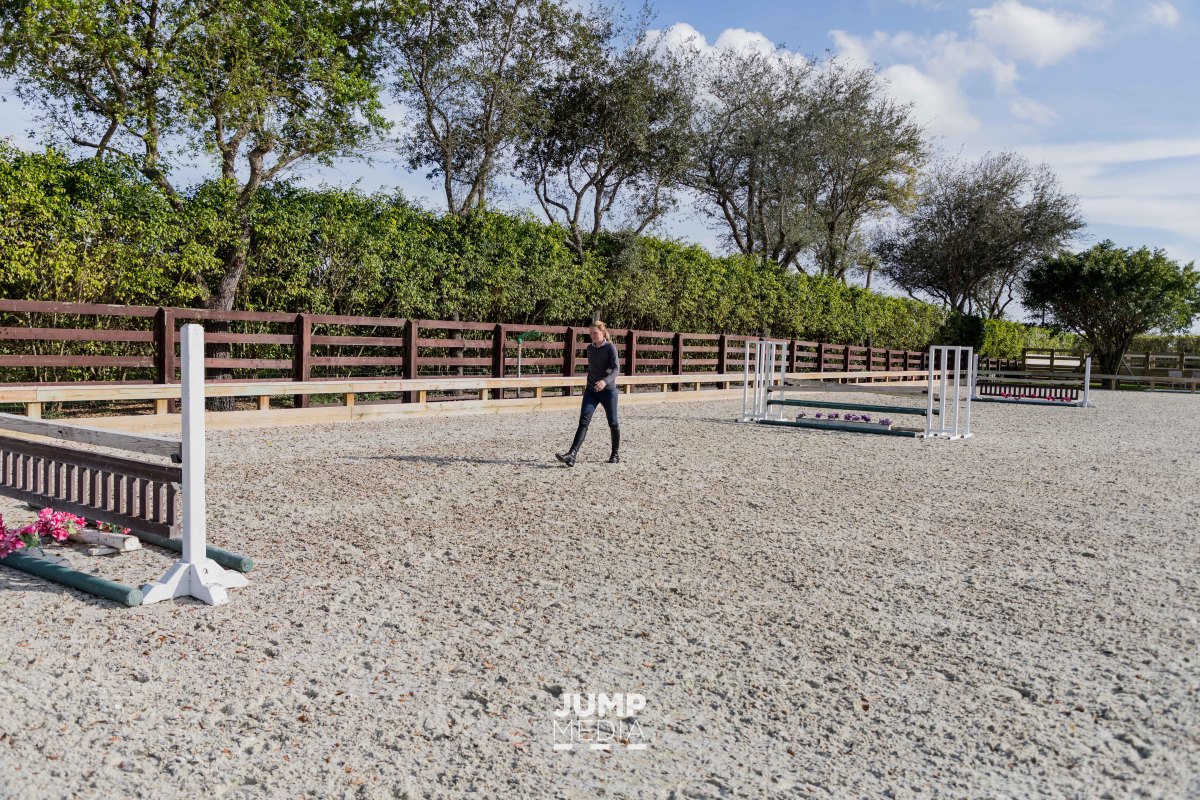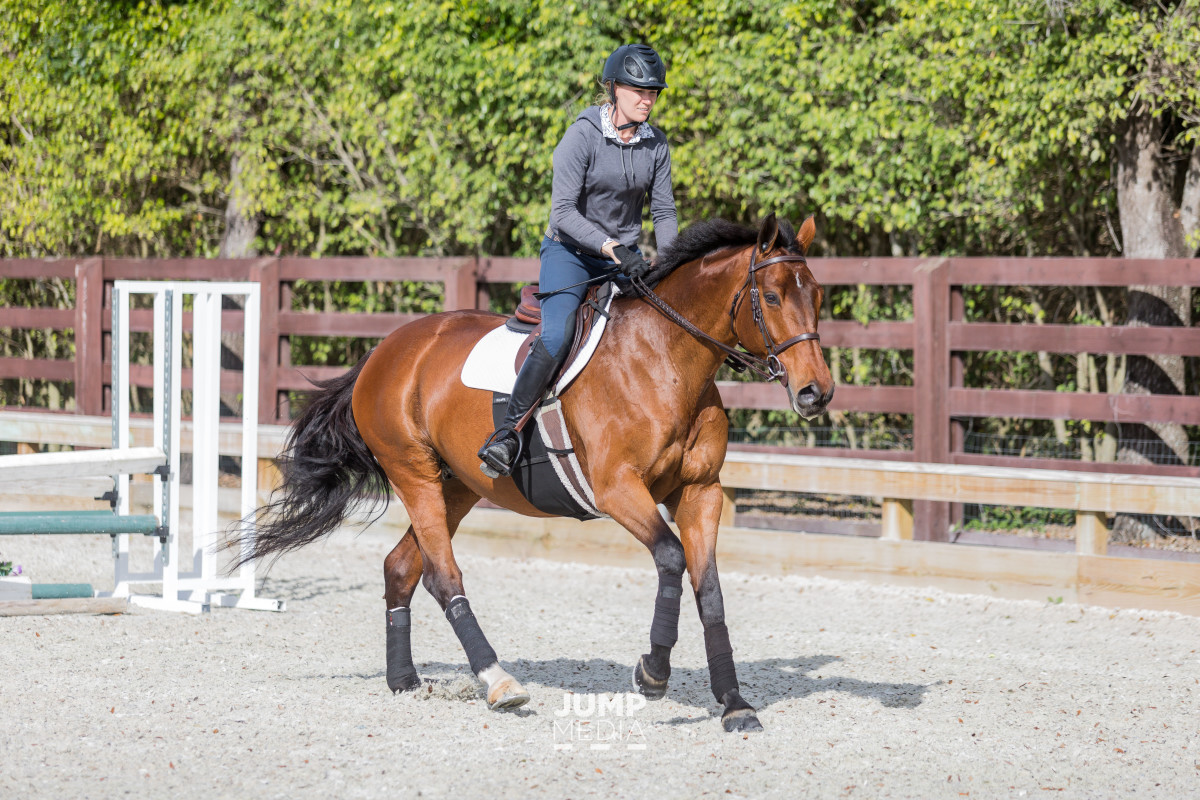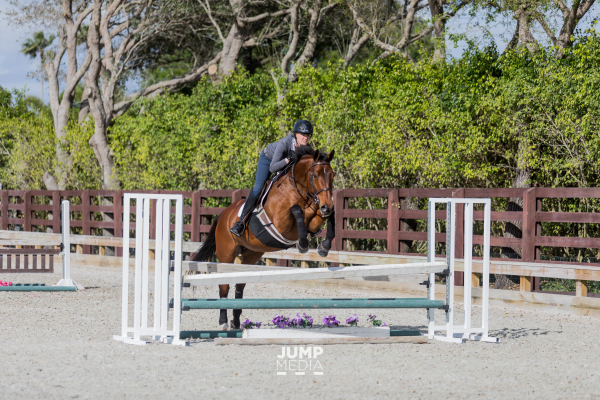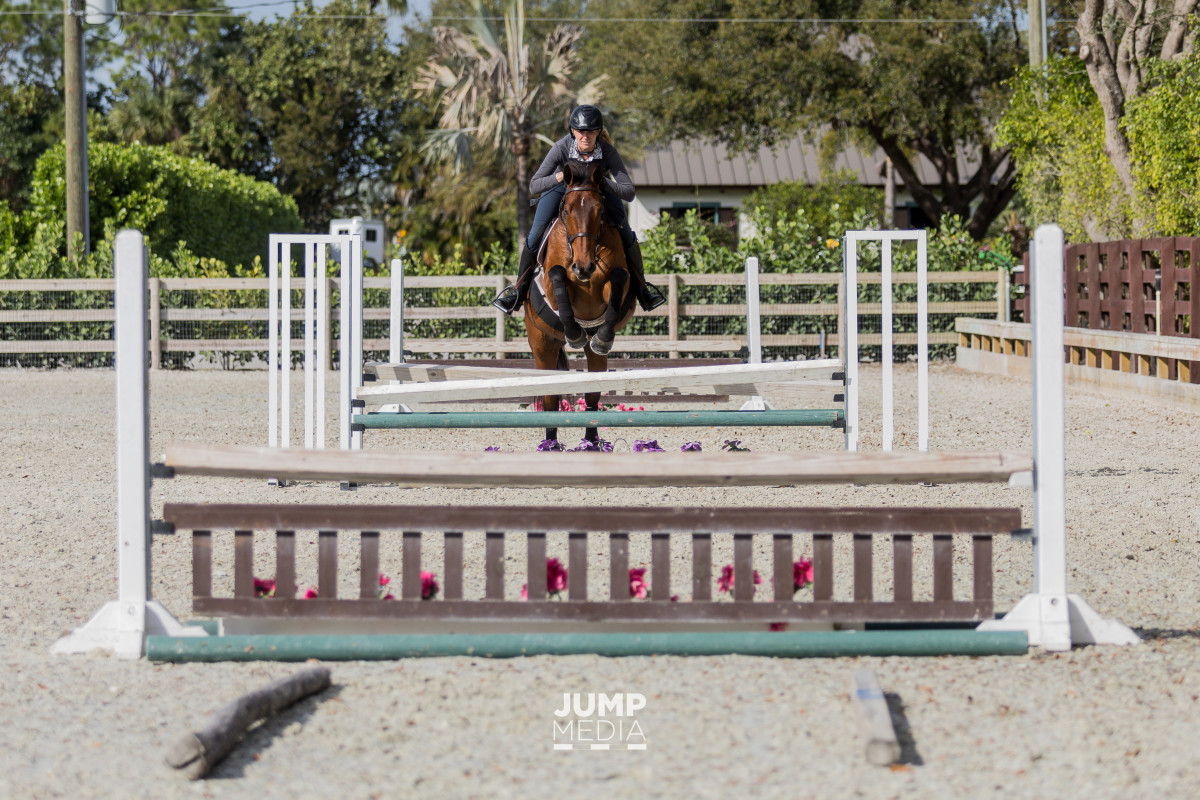The days leading up to a show are great opportunities to make sure my students and horses are ready to shine. Whatever strengths and weaknesses a pair might have, refreshing the basics is a good idea. Establishing straightness and focus in a line is imperative to produce a high score in the hunter ring and a clear round in the jumpers. A crooked or drifting horse does not make for a smooth trip in either ring, which affects scores for the hunters and can result in rails for jumpers. There’s one exercise that you will usually find in my ring when getting ready for shows. It’s a basic practice line with no fancy name, so we can call it the “three to three.”
Three to Three: The Setup
This exercise is a three-stride to a three-stride, which includes a vertical to an oxer to another vertical. The line should be jumpable in both directions with ground lines on either side placed directly under the rails, and I usually place it near the rail to mimic a line in a show course. The specific benefits of the “three to three” as preparation for a horse show are numerous, but also practical. The outside line at a show can be a very distracting place for both horse and rider. If focus can be established at home, there’s a greater chance that it can be replicated while cantering to a line next to spectators, judges, concessions, etc.

I measure both three-stride distances at 45 feet to start and adjust as needed for the horse or as the jumps get bigger. The exercise can be made simple with the jumps set at low, inviting heights. It can also be more challenging with taller fence heights. To help the horse, ground poles can be added along the sides to act as “lanes” helping to maintain straightness, high sides (a pole set a few holes higher on one side) can be created to prevent drifting or poles can be set on the takeoff and landing side to reinforce both starting and finishing the exercise on a straight line. Distances between the jumps can be changed to accommodate a bigger takeoff and landing to larger jumps, a shorter distance to help a horse who gets fast heading towards the in-gate to back off or a longer distance for a horse who needs to practice lengthening his stride going away from the gate.
You can turn to the “three to three” if you find yourself fitting into one of the following five scenarios, but I find that any rider on any horse can benefit from it:
- A crooked horse who likes to drift in a line or at the jumps.
- A rider with a tendency to cut corners on course.
- A nervous rider, or one who is hesitant about moving up to bigger jumps.
- Young horses who need to learn straightness and focus.
- Seasoned horses who require a reminder to help their rider to stay straight.
Bonus: Anyone looking to sharpen up before walking in the show ring!
Let’s Jump It
On any given day, I could school a 5-year-old hunter or teach a student on a 10-year-old jumper through this same line. With the 5-year-old, my goal is to get him to focus on three jumps in a row instead of outside the ring. With the 10-year-old jumper, my goal is to have him stay balanced at the out of the second “three” and not pull his rider coming toward the in-gate.
This horse in particular is a 16-year-old Westfalen mare named Cara who competes in the 3-foot Adult Hunter division. She is a very experienced horse, but her rider has a tendency to cut corners on both the approach to a line and while riding away from it. Cara also likes to drift right on takeoff. This is a good tune-up line for Cara so that she is reminded to: 1. stay between both legs and reins in the corners, 2. go straight through the line and 3. stay straight over the top so she can make square jumps.
After warming up on the flat, I start by jumping a couple cavallettis or small fences. I then jump through the three-stride line followed by a smooth halt in a straight line. Experienced horses tend to anticipate turns, which often leads to missed lead changes or shallow corners. If they have to go straight through a line and halt at the end, they start to wait for direction from the rider. In my barn, there are a lot of veteran show horses who know their job, but they still need reminders.

Once Cara and I have jumped through the line a couple of times off both leads with straight jumps and quiet halts, we’re ready to move on to the next step. This is the time to go up with the jump height if necessary and start tailoring the exercise to the horse and rider. As we established, Cara likes to drift right, so I make the oxer a Swedish (the poles slant in opposite directions, so that they appear to form an “X” shape when seen head on) with the higher side [of the front rail] on the right. I also make the lanes slightly left of center to encourage her to stay in the middle, and switch them when we go the other direction. Cara is a careful horse and holds herself off the jumps once they get bigger, so it means I need to add a bit of leg and encourage her to get up to the outs of both “threes.” I change directions with a simple change through the trot with a leg-yield. Fence heights and widths, as well as line distances will vary depending on what you’re preparing for and the needs of your horse.

Nailing this exercise means: 1. your horse is turning evenly on all four legs (not cutting in or falling to the outside), 2. your horse produces three straight jumps, 3. your horse takes three even steps in both lines and, 4. your horse lands waiting for your direction.
Variations and Benefits
The “three to three” is designed to help any horse stay straight without a lot of interference from the rider. I have a couple horses who tend to drift in one direction or the other, so I include variations, like making a lane or chute of poles on the ground at the takeoff and landing. Some greener horses might require more poles and longer chutes to guide them. Also, as with Cara, the center oxer can be set as a Swedish to encourage the horse to aim for the center.

Lines of jumps, especially three in a row, can sometimes be intimidating for riders. In that scenario, I will often include a chute before and after the line and in between each fence. This naturally encourages the horse to stay straight so the rider can pick a distance and then focus on their position.
I sometimes play with striding, but the “three to three” works best in my ring (which measures 120’ x 235’). There is room on both ends to ride up and out of the turn, and the halts or turns after the jumps aren’t abrupt.
The key point to remember with the “three to three” is that it is not designed to be trappy where the exercise deceives the horse or rider into making a mistake; it’s meant to ride a little forward where any distance will get you out of the line successfully. It is meant to help horses and riders gain confidence while teaching straightness and practicing focus. The beauty of an exercise like this is that because of the variation options, you’re never too far away from making it right for any horse.
About Jane Ehrhart and River Hill Farm
Led by rider and trainer Jane Ehrhart, River Hill Farm is a private training facility based in Wellington, Florida. River Hill Farm is a place where junior and amateur riders can reach their goals, find success with their horses and enjoy their passion for horse sport in a positive environment. Jane has trained riders to wins and championships at notable events that include the National Horse Show, Washington International Horse Show, Longines Global Champions Tour competitions in Monaco, Paris, and Vienna, Winter Equestrian Festival, and USEF Junior Hunter Finals. Find River Hill Farm on Facebook and Instagram for a look into Jane’s boutique training business, as well as behind-the-scenes updates from her horses and riders.










